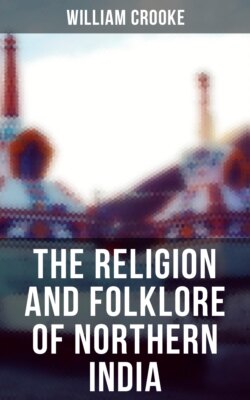Читать книгу The Religion and Folklore of Northern India - William Crooke - Страница 58
На сайте Литреса книга снята с продажи.
Hanumân as a Village Godling.
ОглавлениеTable of Contents
But whatever may be the origin of the cult, the fact remains that he is a great village godling, with potent influence to scare evil spirits from his votaries. His rude image, smeared with oil and red ochre, meets one somewhere or other in almost every respectable Hindu village. One of his functions is to act as an embodiment of virile power. He is a giver of offspring, and in Bombay women sometimes go to his temple in the early morning, strip themselves naked, and embrace the god.8 Mr. Hartland has collected many instances of similar practices. Thus a cannon at Batavia used to be utilized in the same way; and at Athens there is a rock near the Callirrhoe, whereon women who wish to be made fertile rub themselves, calling on the Moirai to be gracious to them.9
On the same principle he is, with Hindu wrestlers, their patron deity, his place among Musalmâns being taken by ’Ali. Their aid is invoked at the commencement of all athletic exercises, and at each wrestling school a platform is erected in their honour. Tuesday is sacred to Mahâbîr and Friday to ’Ali. Hindu wrestlers on Mahâbîr’s day bathe in a river in the morning, and after bathing dress in clean clothes. Then taking a jar of water, some incense, sweets, and red or white flowers, they repair to the wrestling school, bow down before the platform and smear it with cow-dung or earth. After this the sweets are offered to Mahâbîr and verses are recited in his honour. Then they do the exercise five times and bow before the platform. When the service is over they smear their bodies with the incense, which is supposed to give them strength and courage. Care is taken that no woman sees the athletes exercising, lest she should cast the Evil Eye upon them.
One special haunt of the monkey deity is what is known as the Bandarpûnchh or “monkey tail” peak in the Himâlayas. They say that every year in the spring a single monkey comes from Hardwâr to this peak and remains there twelve months, when he makes way for his successor.
Hanumân is a favourite deity of the semi-Hinduized Drâvidian races of the Vindhya-Kaimûr plateau. “The most awe-inspiring of their tremendous rocks are his fanes; the most lovely of their pools are sacred by virtue of the tradition of his having bathed in them.” He was known as Pawan-kâ-pût, or “son of the wind,” which corresponds to his older title of Marutputra, or “son of the wind god.” And the Bhuiyas of Sinhbhûm, who are, as Colonel Dalton gravely remarks, “without doubt the apes of the Râmâyana,” call themselves Pawan-bans, or “sons of the wind,” to this day.10 But in the plains his chief function is as a warden or guardian against demoniacal influence, and at the Hanumângarhi shrine at Ajudhya he is provided with a regular priesthood consisting of Khâki ascetics.
The respect paid to the monkey does not need much illustration. The ordinary monkey of the plains (Macacus Rhesus) is a most troublesome, mischievous beast, and does enormous mischief to crops, while in cities he is little short of a pest. But his life is protected by a most effective sanction, and no one dares to injure him.
General Sleeman11 tells a story of a Muhammadan Nawâb of Oudh, who was believed to have died of fever, the result of killing a monkey. “Mumtâz-ud-daula,” said his informant, “might have been King of Oudh had his father not shot that monkey.” In the Panjâb an appeal to the monkey overcomes the demon of the whirlwind. There is a Bombay story that in the village of Makargâon, whenever there is a marriage in a house, the owner puts outside the wedding booth a turban, a waist-cloth, rice, fruits, turmeric, and betel-nuts for the village monkeys. The monkeys assemble and sit round their Patel, or chief. The chief tears the turban and gives a piece to each of them, and the other things are divided. If the householder does not present these offerings they ascend the booth and defile the wedding feast. He has then to come out and apologize, and when he gives them the usual gifts they retire.12 The feeding of monkeys is part of the ritual at the Durgâ Temple at Benares, and there, too, there is a king of the monkeys who is treated with much respect. Instances of Râjas carrying out the wedding of a monkey at enormous expense are not unknown. Where a monkey has been killed it is believed that no one can live. His bones are also exceedingly unlucky, and a special class of exorcisers in Bihâr make it their business to ascertain that his bones do not pollute the ground on which a house is about to be erected.13
The worship of Hanumân appears, if the Census returns are to be trusted, to be much more popular in the North-West Provinces than in the Panjâb. In the former his devotees numbered about a million, and in the latter less than ten thousand persons. But the figures are probably open to question, as he is often worshipped in association with other deities.
